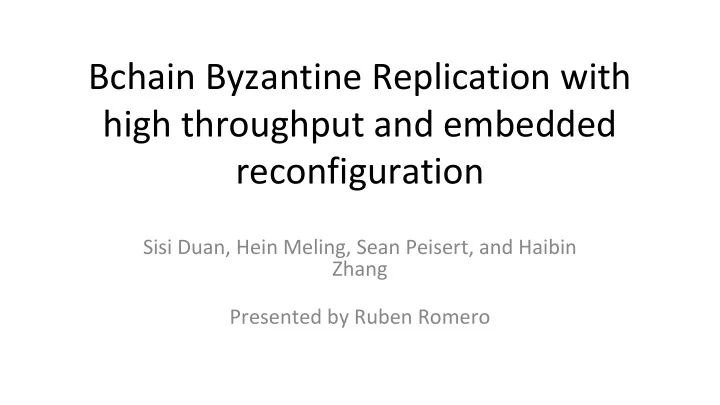

Bchain Byzantine Replication with high throughput and embedded reconfiguration Sisi Duan, Hein Meling, Sean Peisert, and Haibin Zhang Presented by Ruben Romero
BChain Protocols • Bchain3: – 3f+1 replicas – Sub protocols: (1) Chaining, (2) Re-chaining, (3) View Change, (4) Checkpoint and (5) Reconfiguration. • BChain5: - 5f+1 replicas - No Reconfiguration protocol
BChain • Safety: – It is hold in any asynchronous environment where messa ges may be delayed, dropped, or deliver out of order • Liveness – Assure assuming that synchrony holds after some unknown stabilization time
Bchain For each replica pj we define P(j), set predecessor, and S(pj), set successor, for replicas in the set A as: -P(pj): if j < f+1 then P(pj) = {ph,p1,...,pj-1}, else P(j) = {pj-f-1,....,pj-1} -S(pj): if 2f+1 < f < f+1 then S(pj) = {pj+1,....,p2f+1}, else S(j) = {pj+1,... pj+f+2 }
Chaining Protocol • Orders clients requests
Chaining Protocol: Step 0 - Client c sends a request <Request, o, T, c> -o: state machine operation to the head p h . -T: Timespan -c: client id
Chaining Protocol: Step 1 -v: View number -Head receives <Request, o, T, c> from C -ch: Number of rechainning -Head sends <Chain, v, ch, N, m, c, H, R, Λ > -c: client id -H: Hash of its execution history to its successor p 1 -R: Hash of reply r to the client containing the execution result - Λ :: Current chain order
Chaining Protocol: Step 2 -Replica p j receives <Chain, v, ch, N, m, c, H, R, Λ > from his predecessor p j-1 that contains valid signatures from P(p j ) -if p j ∈ f+1 last replicas in A it updates H and R -It appends its signature -Send <Chain, v, ch, N, m, c, H, R, A> to its successor p j+1. -Set a timer Δ 1 . Expecting ACK or SUSPECT message
Chaining Protocol: Step 3 -Proxy tail p 2f+1 receives <Chain, v, ch, N, m, c, H, R, Λ > from its predecessor p 2f that contain valid signatures from P (p2f+1) -Updates H and R and appends its signature. -Sends reply to client -Sends <ACK,v, ch, N, m, c, H, R, Λ > to its p 2f -Sends <Chain, v, ch, N, m, c, H, R, A> to its all replicas in B
Chaining Protocol: Step 4 -Client complete the request if it receives reply from proxy that contains the signatures of last f+1 replicas in A. -Otherwise. It retrasmites the request to all replicas.
Chaining Protocol: Step 5 -Replica p j recieves <ACK,v, ch, N, m, c, H, R, Λ > from its successor p j+1. (ACK message contains valid signatures from S(p j )). Thus, it commits the request. -Appends its signature. -Sends <ACK,v, ch, N, m, c, H, R, Λ > to its predecessor p j-1 . -Sends <Chain, v, ch, N, m, c, H, R, Λ > to all replicas in B
Chaining Protocol: Step 6 -Replicas in B collect f+1 CHAIN matching messages -Then execute and commit the operation
Rechaining Protocol- Failure detector Head: Handling a suspect message: -increasing ch -new Λ -sending chain message Forward also to the head
Rechaining Protocol
Rechaining Protocol
Rechaining Protocol 2+ 1 3
Time setup and preventing performance attacks Time setup: Δ 1,i for each replica i= F( Δ 1,i,l i ) such that if i = 0 , l h = 1 and Δ 1,h = F( Δ 1,1) = Δ 1, If i = 2f+1, l p = 2f+1 and Δ 1,2f+1 = F( Δ 1,2f+1) = 0 Performance threshold Δ ’ 1,pi < Δ 1,pi If average time answer is higher that Δ ’ 1,pi. Replica starts suspect procedure
View Change protocol 1- Select a new head when the current one is deemed faulty 2- Adjust timers to ensure eventual progress
View Change protocol 1- Select a new head when the current one is deemed faulty: A correct replica votes for VIEWCHANGE if: 1- It suspects the head to be faulty. 2- It receives f+1 <VIEWCHANGE> messages.
View Change protocol 1- Select a new head when the current one is deemed faulty: If a replica votes for a VIEWCHANGE: -Move to a new view -Send <VIEWCHANGE,......> to all replicas -Stop receiving messages except: <CHECKPOINT>, <NEWVIEW>, and <VIEWCHANGE>
View Change protocol 1- Select a new head when the current one is deemed faulty: When new head collect 2f+1 <VIEWCHANGES>: -Send <NEWVIEW,......, new Λ , set valid viewChange messages, set of CHAIN messages> to all replica -In the new Λ , the previous head was moved to the end of the chain
View Change protocol 2- Adjust timers to ensure eventual progress: Δ 1 = Timer for rechaining Δ 2 = Timer for current view when replica is waiting for a request to be committed Δ 3 = Timer for new view
View Change protocol 2- Adjust timers to ensure eventual progress:
Reconfiguration protocol It is a general technique, often abstract as stopping the current state machine and restarting with a new set of replicas. BChain reconfiguration concerns with re-chainning to replaces faulty replicas with new ones.
Checkpoint Protocol • Similar to the PBFT • It is used to bound the growth of message log and reduce the cost of view changes
Questions
Recommend
More recommend